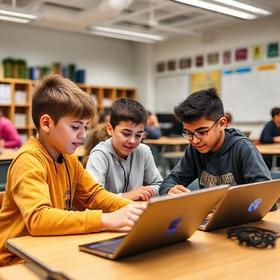Digital Learning and Public Schools: What Parents Need to Know
Digital learning and public schools are now deeply interconnected. Since 2020, districts have expanded technology investments, added new instructional models, and integrated online tools across grade levels. In 2025, digital learning and public schools continue to evolve at a rapid pace, creating both opportunities and challenges for families.
This guide explains what parents need to know about digital learning and public schools today, including how schools use technology, the academic impact, equity issues, and practical questions to ask administrators. The article incorporates insights from recent district initiatives, ongoing research, and interviews with public school technology leaders.
How Digital Learning Shapes Today’s Public Schools
Digital learning and public schools intersect in several ways. Schools incorporate technology into instruction, assessment, communication, and support services. Understanding this landscape helps parents better evaluate their district’s digital strategy.
Common Components of Digital Learning
Public schools typically rely on four pillars of digital learning.
1. Classroom Technology Tools
Digital tools for instruction vary by district, but commonly include:
Learning management systems, such as Google Classroom or Canvas
Adaptive learning platforms for math and literacy
Virtual science labs and simulations
Digital textbooks
Classroom devices like Chromebooks or tablets
For parents exploring how schools integrate digital methods, the overview of technology adoption on Public School Review offers helpful context.
2. Hybrid and Blended Learning Models
Many public schools combine online instruction with in-person teaching. These models allow students to learn at their own pace, make up missed work, and access enrichment activities outside normal hours. Digital learning and public schools work together to support differentiated instruction through these flexible models.
3. Digital Assessment Tools
Computer-adaptive tests and real-time progress dashboards allow teachers to track student learning more precisely. Districts use assessment data to identify gaps earlier than in the past.
4. Virtual Support Services
Digital learning also supports:
Teletherapy for speech and counseling
Online tutoring
Virtual office hours
Parent portals for grades, attendance, and communication
Why Digital Learning Matters for Families
Digital learning and public schools have aligned their strategies around improving student outcomes, but the benefits depend on how effectively districts implement these tools.
Benefits of Digital Learning in Public Schools
Personalized Learning
Adaptive platforms adjust difficulty based on student performance. This helps advanced learners move ahead while supporting students who need remediation.
Real-Time Feedback
Many schools now provide instant feedback on assignments, which can improve student engagement and reduce the time between learning a concept and receiving support.
Expanded Course Access
In rural or under-resourced districts, digital learning and public schools work together to offer:
Advanced Placement courses
World languages
Career technical electives
Dual-enrollment opportunities with community colleges
For families evaluating CTE pathways, Community College Review includes helpful background on dual-credit partnerships.
Support for Diverse Learners
Assistive technology tools, such as text-to-speech, captioning, and translation software, help students with disabilities, multilingual learners, and students needing reading support.
Family Engagement
Parent portals and real-time gradebooks give families greater visibility into academic progress. Districts frequently cite digital communication as a key factor in improving home-school collaboration.
Challenges and Concerns Parents Should Consider
Although digital learning and public schools are increasingly interconnected, parents should understand potential drawbacks.
1. Screen Time and Digital Balance
The American Academy of Pediatrics emphasizes the importance of balanced device use. Excessive screen time can affect sleep patterns, physical activity, and attention. Parents should ask schools how they structure device-free instructional time.
2. Digital Equity
Reliable internet access and device availability remain uneven. Many districts now provide personal Wi-Fi hotspots, and some cities invest in municipal broadband. The National Center for Education Statistics tracks technology access trends, which can help families evaluate district progress.
3. Data Privacy
Districts collect significant student data. Parents should understand:
What data is collected
How long it is stored
What third-party vendors can access
Resources such as the Student Privacy Compass explain FERPA obligations in plain language.
4. Instructional Quality
Digital learning enhances instruction only when teachers receive adequate training. Districts with strong professional development programs experience higher student achievement gains.
5. Cybersecurity Risks
Ransomware attacks on school systems continue to rise. Parents should ask how districts secure networks and educate students on safe online practices.
How Schools Are Strengthening Digital Learning in 2025
Digital learning and public schools work closely to refine instructional practices. Several improvements are becoming standard.
Teacher Professional Development
Districts increasingly require training in:
Digital pedagogy
Data literacy
Cyber safety
Assistive technology implementation
Educators report that structured training improves instructional consistency across classrooms.
Improved Learning Platforms
Schools have adopted platforms with built-in features such as:
Offline mode for students without consistent internet
Real-time messaging between teachers and students
Integrated assessment dashboards
AI-assisted writing feedback
Stronger Parent Communication Tools
In 2025, most districts will use centralized apps to send school updates, attendance alerts, and homework reminders.
A Practical Framework for Parents
Parents evaluating digital learning and public schools can use the following questions when meeting with teachers or administrators.
Instruction
How is digital learning used in daily classroom instruction?
Are digital tools supplemental or required?
Technology Access
What device will my child use?
What happens if the device breaks or is lost?
Is internet support available for families?
Support Services
Are tutoring, teletherapy, or after-school virtual sessions offered?
How does the school help students who struggle with technology?
Safety and Privacy
How does the school protect student data?
Are teachers trained in cybersecurity awareness?
Screen Time Guidelines
How much of the school day involves screens?
How is non-screen activity balanced with digital tasks?
Comparison: Digital vs Traditional Learning Features in Public Schools
| Feature | Digital Learning | Traditional Learning |
|---|---|---|
| Access to resources | High, available 24/7 through platforms | Dependent on classroom materials |
| Personalization | Adaptive tools adjust content | Teacher differentiation required |
| Feedback speed | Instant through online tools | Varies by teacher workload |
| Family insight | Parent portals and dashboards | Periodic updates from school |
| Equity challenges | Internet and device gaps | Transportation and resource access |
This table illustrates how digital learning and public schools combine both methods to create a balanced instructional environment.
What the Future Holds
Digital learning and public schools will continue integrating AI-driven tools to support individualized instruction. Districts are exploring:
Virtual reality field trips
AI-guided reading tutors
Data-driven early warning systems for at-risk students
Expanded tele-counseling services
As technology advances, schools are also emphasizing student digital citizenship, including online research skills, media literacy, and responsible social media use.
Families should expect more personalized pathways, especially at the high school level. Early college programs, CTE courses, and virtual electives will continue expanding access to learning opportunities that were once limited to large or affluent districts.
Conclusion
Digital learning and public schools operate together to shape a modern and adaptable education system. The most effective districts use technology to enhance, not replace, strong instruction. Parents who understand how digital tools work, where challenges remain, and what questions to ask can better support their children’s academic growth.
When used thoughtfully, digital learning and public schools provide students with new opportunities, more personalized instruction, and deeper engagement. Families who stay informed and work closely with teachers can help ensure that digital learning supports a productive, healthy, and balanced school experience.














